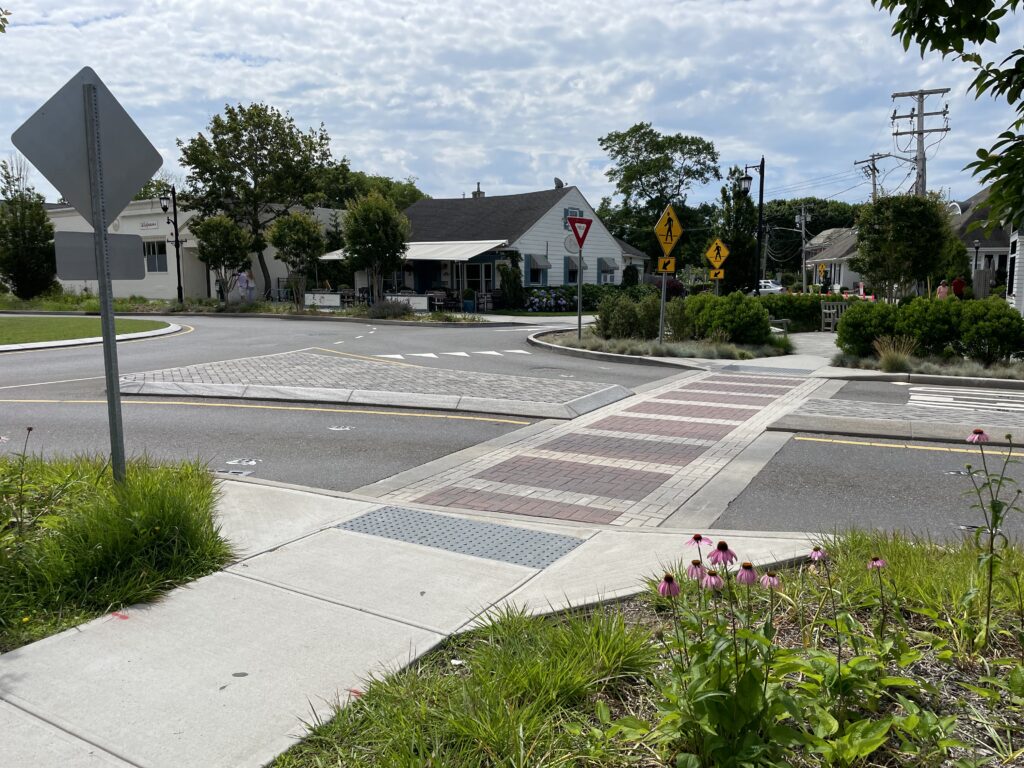Storm Safe Hardscape: New Vision Overhauls Local Infrastructure

The Incorporated Village of Westhampton Beach is a quaint seaside community on the southeast coast of Long Island, New York. Regularly suffering from coastal storm damage, Main Street endured frequent flooding, cracked pavements, and worn pedestrian crossings. When a corridor of 2,100 feet of roadway and sidewalks reached the end of its lifecycle, the Village decided that simply replacing and repaving the status quo was no longer adequate; it was time to revitalize Main Street in favor of a new vision that would overhaul local infrastructure and prioritize long-term sustainability, stormwater control, and an improved pedestrian experience.
To meet the Village’s long-term sustainability goals, H2M developed plans which buried overhead utilities underground to eliminate the risk of power outages due to downed wires during a storm. Doing so cleared ground-level space to permit new roadway configuration possibilities. Two new roundabouts now anchor the corridor and maintain steady traffic flow. They are bordered with granite mountable curbs and in-filled with previous white square grass pavers surrounding a focal planting bed. The roundabouts are scaled to accommodate passenger cars, emergency vehicles, and some smaller trucks and will allow larger trucks to encroach on the curb if necessary. Granite curbs last longer than concrete under the wear and tear of truck traffic. The grass pavers blend into the grass from most angles and will distribute the weight of trucks across the grass, preventing tire tracks from deteriorating into the mud.
To manage stormwater quality, street trees were planted in five-foot-wide permeable pavement strips that will filter impurities from stormwater runoff. Within the strips, the trees are set in tree grates made from recycled plastic. Additionally, under the impervious concrete sidewalks, is a layer of structural soil that will give tree roots space to grow, thereby reducing pavement heaving. The chosen tree species are a combination of shad and tightly upright columnar trees, the latter of which was chosen to avoid obscuring store signage, a major concern for local business owners.
The most significant project enhancements improved the pedestrian experience. The design team widened the sidewalk and narrowed the street to calm traffic, and included planted curb extensions to shorten crosswalk distances. The crosswalks are made of red and white impervious pavers and are elevated to sidewalk height at major intersections. These further calm traffic and emphasize that this space prioritizes people over vehicles. From an aesthetic perspective, the pavers also look nicer than striped asphalt and improve the area’s visual appeal. Crosswalks at the roundabouts also have “splitter islands” that offer pedestrians refuge halfway across the street if traffic is not clear.
The wider sidewalks now have pocket parks that feel protected and separate from traffic with outdoor seating on pervious pavers set amongst deer-resistant deciduous and evergreen shrubs, ornamental grasses, and perennial plantings. The tree-lined corridor will mature to provide shade and comfort for visitors, establishing a classically sophisticated character for the area.
Finally, in front of the performing arts center, there is a mosaic of granite pavers with the name of benefactors. This sidewalk mosaic pre-dates the streetscape improvements, so the team carefully removed each paver and re-installed each back into its designated place after reconstruction.
Feedback from the community, published in local newspapers, described the changes as “universally loved” and “more inviting,” explaining it as looking “like a town right out of a movie.” As the COVID lockdown restrictions eased, these new changes have accommodated the crowds eager to meet again in person. One magazine boasted that the transformation on Main Street should serve as a model of downtown revitalization that should be copied all over Long Island.
This article also appeared on LandscapeArchitect.com and can be read here.



